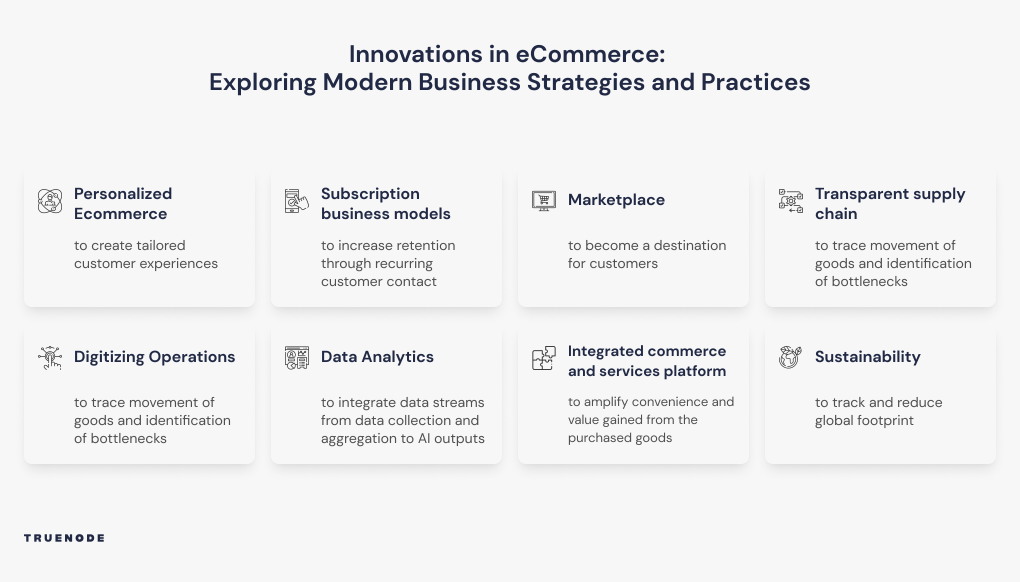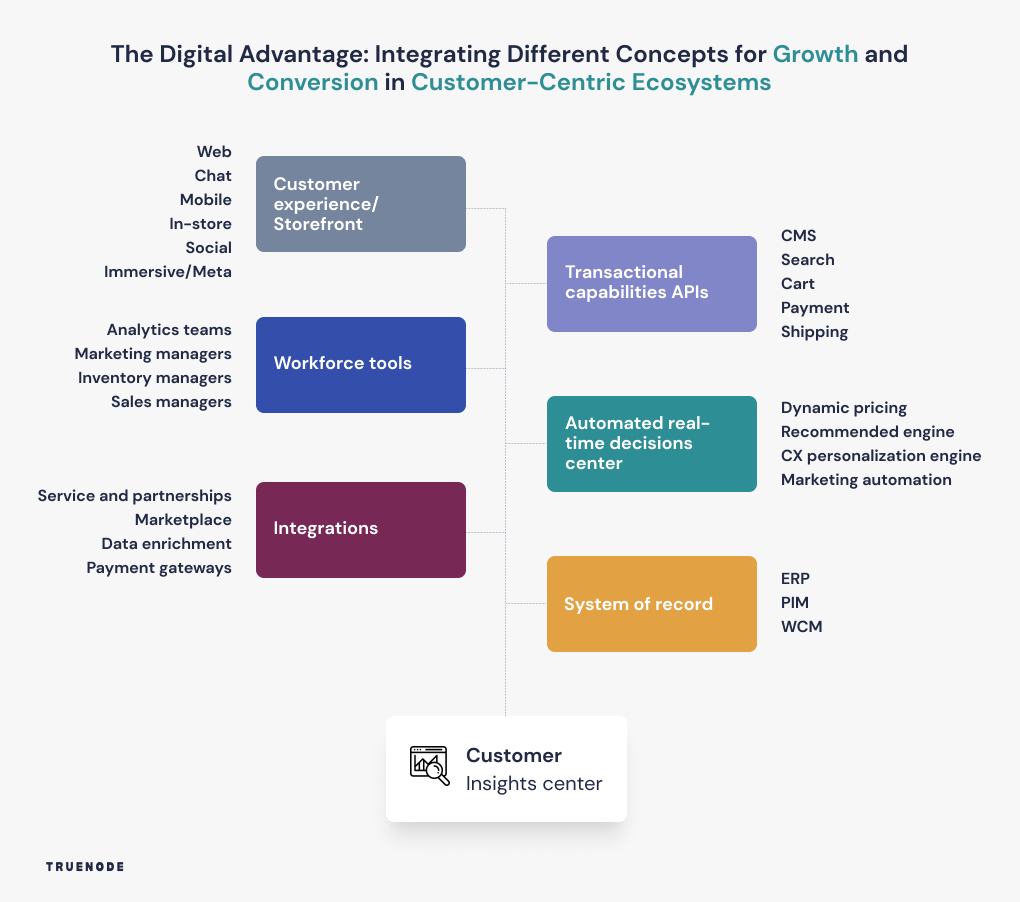Article

Revolutionizing eCommerce: Unlocking Growth and Efficiency with Innovative Technologies and Customer-Centric Strategies
The rapid advancement of technology and the utilization of data have presented brands with a significant opportunity to redefine their business models, customer interactions, and product development strategies in order to remain competitive in the market.
Today’s consumers desire more than just simple transactions; they are willing to pay more for captivating shopping experiences. Various survey findings indicate a growing interest among customers in embracing innovative technologies while shopping. Whether it’s AI-powered chatbots, Virtual and Augmented Reality (VR/AR), omnichannel experiences, voice-assisted shopping, or other advancements, these technological developments are reshaping the way consumers engage with brands and make purchasing decisions. Failing to meet their needs jeopardizes the future of a business.
By embracing technologies tailored to shoppers’ needs and prioritizing tools that enhance operational efficiency throughout the value chain, businesses can unlock a multitude of benefits. This approach is crucial, not only for enhancing personalization and fostering customer loyalty but also for generating new avenues for scalability and revenue growth.
This article delves into the transformative aspects of eCommerce development through the lenses of our approach at TrueNode. It focuses on key business topics, emerging technology trends, and the critical importance of customer-centric ecosystems.
Driving Growth in eCommerce: Exploring Modern Business Strategies and Use Cases
The world of eCommerce is constantly evolving with innovative ideas that shape how businesses operate and engage with customers. From transparent supply chains to personalized experiences, integrated platforms to data-driven decision-making, let’s delve into various business use cases worth exploring.

Personalized eCommerce: Brands can now utilize sophisticated data analytics and machine learning algorithms to offer personalized recommendations, creating a shopping experience that feels like a conversation with a trusted friend. By understanding their customers’ tastes, preferences, and aspirations, companies can build long-lasting relationships that go beyond mere transactions.
Subscription Business Models: Today, eCommerce is more than just one-time purchases—it’s about building lasting connections. By adopting a subscription-based model, brands can create an exclusive club, for example, where members enjoy curated collections, personalized advice, and early access to limited editions. By nurturing these transformative relationships, the brands become an indispensable part of their customers’ lives.
Marketplaces: The power of eCommerce lies in its ability to connect people and possibilities. By embracing a diverse range of sellers, marketplaces provide brands with the opportunity to expand their reach and offerings, becoming a bustling hub of unique products and stories. Customers, in turn, delight in the vibrant tapestry of choices, creating a community driven by shared passions.
Transparent Supply Chain: In the realm of eCommerce, it’s crucial to know the whereabouts of your products and how they move. By using cutting-edge tracking technology, brands not only ensure timely deliveries but also improve efficiency, decrease waste, and build trust by eliminating hidden bottlenecks.
Digitizing Operations: Behind the scenes, eCommerce is a complex symphony of operations. However, successful brands understand the importance of simplicity. By digitizing their operations and streamlining their entire value chain, brands can eliminate unnecessary complexities, allowing their teams to focus on what truly matters—delivering exceptional customer experiences. From inventory management to order fulfillment, every step is streamlined, ensuring smooth operations as simple as clicking “Buy Now.”
Data Analytics: Data is the heartbeat of eCommerce, but insights are the lifeblood that fuels success. A data-driven strategy allows for uncovering hidden patterns, preferences, and trends. By leveraging these insights, companies can make informed decisions that resonate with their customers.
Integrated Commerce and Services Platform: Seamless experiences and convenience reign supreme in eCommerce. By integrating the online store with an array of value-added services such as product installations, on-demand tech support, and extended warranties, customers can shop with confidence, knowing that their purchase comes with expert support and peace of mind.
Sustainability: Now more than ever, brands need to take the planet seriously. By tracking their environmental footprint and partnering with ethical suppliers, businesses can amplify convenience while promoting the value gained from purchased goods. Customers feel good about their choices, knowing that their fashion statement aligns with their values.
Building a Customer-Centric Ecosystem: Aligning Technology for Enhanced User Experiences and Operational Efficiency
With limited resources and multiple transformation goals, brands must strategically invest in technology that prioritizes the most relevant experiences for shoppers while also enhancing operational efficiencies.
To achieve this, brands need to focus on developing customer-centric digital ecosystems that integrate various concepts to accelerate growth, improve conversion rates, and streamline business processes. These ecosystems are composed of several layers, each serving a specific purpose.

Presented below are some of the fundamental functions encapsulated within a Customer-Centric Ecosystem.
Storefront and Transactional Layers: These layers provide numerous customer touchpoints to maximize interactions and gather valuable data. By optimizing the storefront experience and transactional processes, brands can enhance customer engagement and facilitate seamless transactions.
Workforce Tools and Real-Time Decision Center: Effectiveness and efficiency are crucial for business operations. By equipping the workforce with advanced tools and establishing a real-time decision center, brands can empower their employees to make informed decisions, streamline workflows, and enhance overall operational performance.
Integrations Layer: This layer enables the integration of third-party data and features into the ecosystem. By leveraging external resources, brands can enrich their platforms with additional capabilities, such as personalized recommendations, advanced analytics, or seamless integration with other services or platforms.
System of Records: Managing product data efficiently is essential for a customer-centric ecosystem. The system of records serves as a centralized repository that stores and maintains accurate and up-to-date product information, ensuring consistency across various channels and touchpoints.
Insights Center: Deep within the ecosystem, the insights center plays a crucial role in collecting and analyzing data from different layers. It acts as a knowledge hub, extracting valuable insights and feeding them back to the different layers of the ecosystem. This continuous learning and feedback loop allows brands to improve decision-making, optimize processes, and enhance the overall customer experience.
The challenge lies in selecting the right use cases that align priorities across different parts of the system. Brands must carefully evaluate their objectives, customer needs, and available resources to determine which technology investments will have the most significant impact on their customer-centric ecosystem.
Headless is the way to go
Within a customer-centric ecosystem, the adoption of a headless approach holds immense potential for enterprises. Its modular and flexible nature aligns perfectly with the ecosystem’s goal of delivering seamless and personalized experiences to customers and enabling operational efficiency.
By decoupling the frontend presentation layer from the backend commerce functionality, headless commerce enables seamless integration of various technologies and helps brands adapt to changing market demands. This flexibility enables businesses to quickly implement new features and capabilities.

Here are some key advantages of embracing the headless approach:
Enhanced Scalability: The headless approach enables efficient scaling of the business by independently scaling different components based on demand, ensuring a seamless shopping experience. Brands can handle high traffic volumes and accommodate future growth without compromising performance.
Omnichannel Experiences: The headless approach enables consistent experiences across multiple channels and devices, providing a unified experience for customers and improving engagement. Brands can deliver personalized content and optimize the customer journey across various touchpoints.
Rapid Innovation and Experimentation: With the help of MACH architecture, companies can quickly introduce new features or technologies without disrupting the entire system, fostering innovation and staying ahead of the competition. Headless allows businesses to experiment with new ideas and iterate rapidly.
Third-Party Integrations: The headless approach allows for easy integration with third-party services and applications, leveraging tools to enhance operations and choose best-of-breed solutions. Brands can leverage a wide range of services and applications to extend their capabilities.
Internationalization and Localization: Headless architecture enables brands to customize and localize content for specific markets while maintaining a centralized backend.
Enhanced Security and Compliance: Headless architecture provides better control over data privacy and security by separating frontend and backend systems.
Artificial Intelligence and Machine Learning: Leveraging AI and ML technologies allows brands to automate processes, personalize experiences, and gain deeper insights into customer behavior, leading to improved sales and customer satisfaction. Headless architecture enables easy integration with AI and ML tools, enabling brands to harness their power effectively.
Voice Commerce Technology: By integrating voice commerce technology, businesses can enhance customer experiences, increase accessibility, and tap into the growing trend of voice-assisted shopping. The headless approach enables seamless integration of voice technology across multiple channels and devices.
Virtual and Augmented Reality: Headless architecture enables the integration of VR and AR functionalities into various touchpoints, creating engaging and immersive shopping experiences.
The headless approach empowers businesses to adapt quickly, deliver personalized experiences, and leverage emerging technologies to stay competitive in the dynamic digital landscape.
Roadmap to renewing an eCommerce landscape: How TrueNode can help you upgrade your eCommerce business?
We offer comprehensive services to support your eCommerce upgrade journey, including auditing your current platform, defining North Star KPIs, mapping user journeys, designing architecture, and selecting the right platform. Moreover, our team of culture-driven and forward-thinking developers will ensure a smooth eCommerce development and will provide ongoing support by leveraging the latest technologies and industry best practices.
Let’s schedule a discovery call to discuss how we can help upgrade your eCommerce business. Get in touch!






